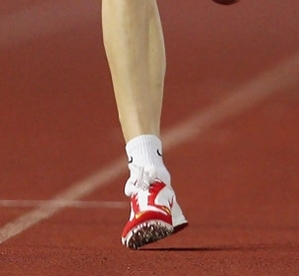Good running form in forefoot running should follow that the balls of the foot closer to the lateral edge contacts the ground before the heel.
However, many inexperienced forefoot runners make the mistake of toe striking, or landing high up on the toes.
Good Running Form in Forefoot Running: Land on Balls, Not Toes
Toe striking is highly injurious because it places greater mechanical work on the plantar flexors, Achilles tendon, ankle, and calves.
Toe striking is actually very rare and is mostly common in runners who first learn forefoot running under the premise that forefoot running is the same as toe running.
In contrast, you will notice that habitual barefoot runners do not toe strike, they forefoot strike, which is actually a much flatter placement. But what is the precise part of the forefoot that makes initial contact with the ground first in forefoot running?

In forefoot running, the first part of the foot to make contact with the ground is the outer-side of the forefoot, underneath the 5th and 4th metatarsal heads.
The video below shows how the foot strikes the ground in a proper forefoot strike. Pay close attention to the middle runner in the black track spikes, and notice how the foot lands on the outer-side of the forefoot before the rest of the foot flattens to the ground.
The Forefoot Strike: Acting without Thinking
Why do habitual forefoot runners, especially habitual barefoot runners, make initial contact on the outer-side (lateral edge) of the forefoot before the rest of the foot flattens on the ground?
Landing closer to the lateral edge of the forefoot at touchdown in forefoot running is a reflexive mechanism evolved by the body throughout our evolutionary history as barefoot endurance runners.
- When running barefoot, initial contact on the lateral forefoot limits impact and shear forces to safe levels through plantar sensory feedback.
Conversely, making initial contact on other areas of the foot such as the heel or high up on the toes when running barefoot results in intense stimulation of the mechanoreceptors causing the body to perceive foot strike as uncomfortable.
The body likes to land on the lateral forefoot first when running barefoot because it feels the most comfortable and is an adaptive strategy to stop loading from approaching levels associated with injury. The brain therefore treats a lateral forefoot strike as a habit, or learned behavior that happens reflexively, without mental effort.
The best way to figure out how the brain stamps a lateral forefoot strike as a habit to prevent injury is by running barefoot, but make sure you ‘lose control of your feet’ upon and at foot strike, letting them fall to the ground like the runner in video.
More From Run Forefoot:
How Cushioned Running Shoes Alter Natural Foot Strike
7 Top Running Shoe Brands for Forefoot Runners
7 Benefits of Running in Minimalist Shoes
How Ditching Heel Strike Helped Meb Win Boston
Most Popular Energy Gels Long Distance Runners Love
P.S. The Run Forefoot Facebook Page is a great place to ask questions related to forefoot running mechanics, injury, barefoot running and footwear. I’m always happy to help!
Bretta Riches
BSc Neurobiology; MSc Biomechanics candidate, ultra minimalist runner & founder of RunForefoot. I was a heel striker, always injured. I was inspired by the great Tirunesh Dibaba to try forefoot running. Now, I'm injury free. This is why I launched Run Forefoot, to advocate the health & performance benefits of forefoot running and to raise awareness on the dangers of heel striking, because the world needs to know.
Latest posts by Bretta Riches (see all)
- Heel Lifts Increase Injury in Runners - 16/04/2024
- Are Minimalist Shoes Good for Seniors? YES! - 14/04/2024
- BIG Deals On Running Gear And More! - 09/04/2024

Leave a Reply